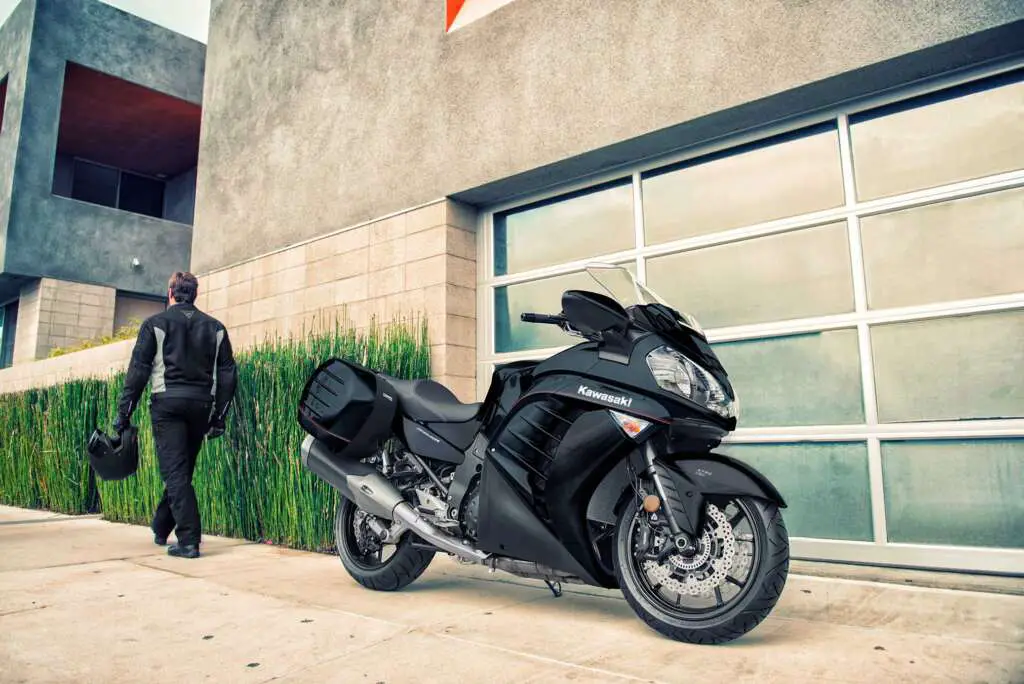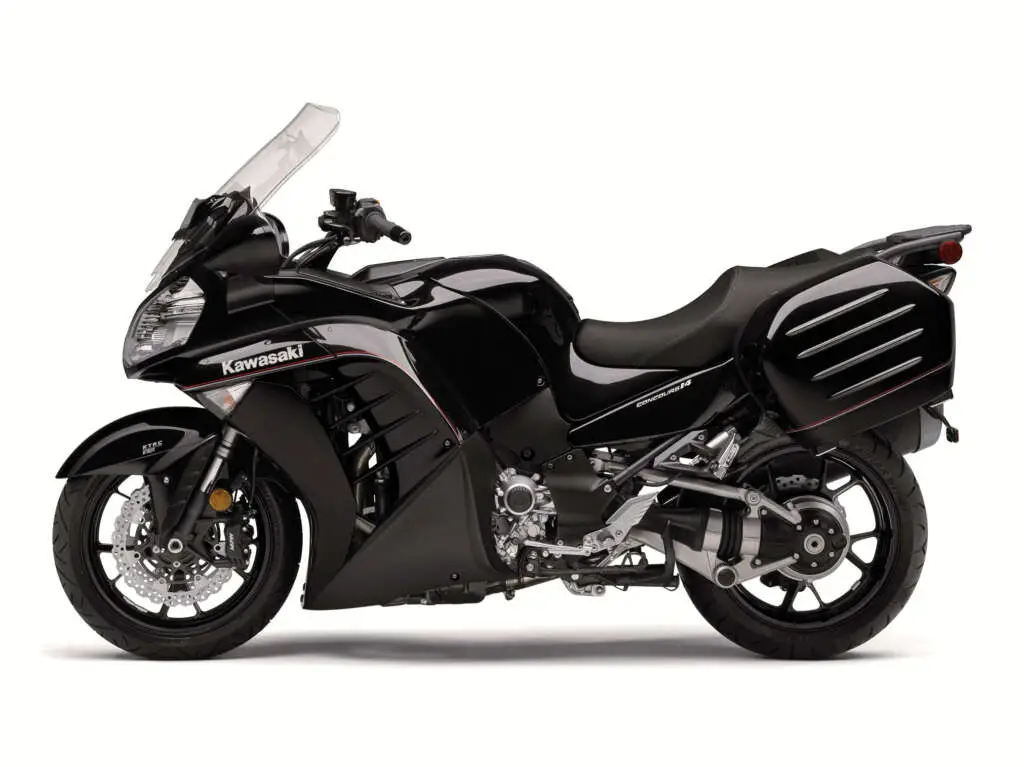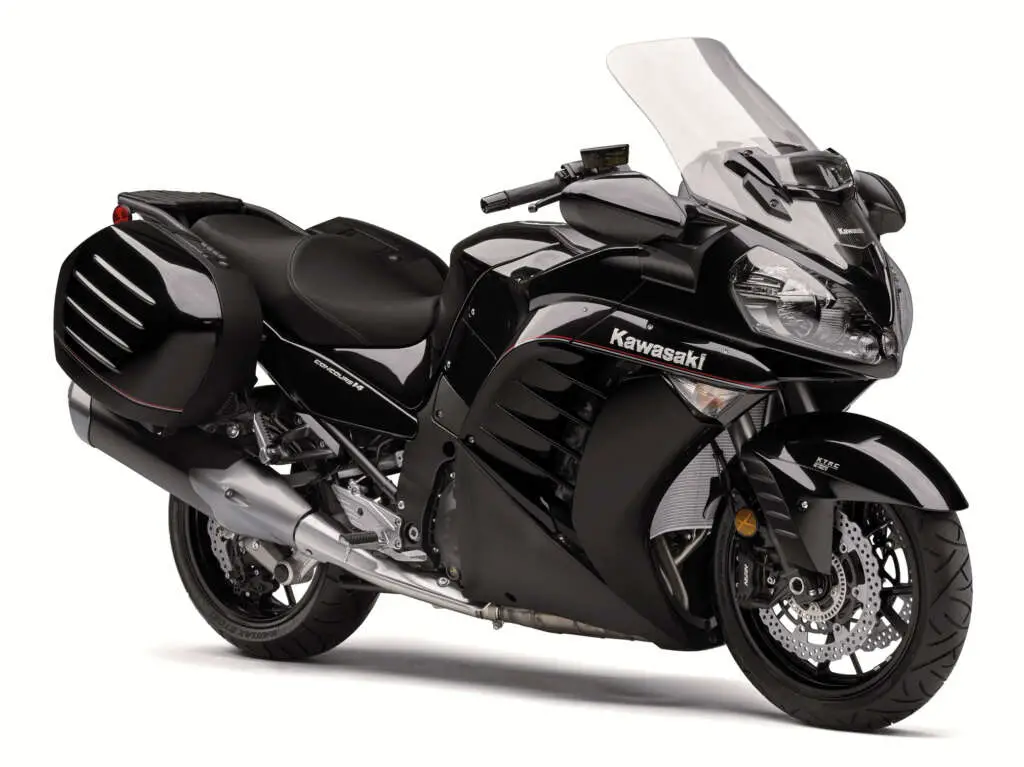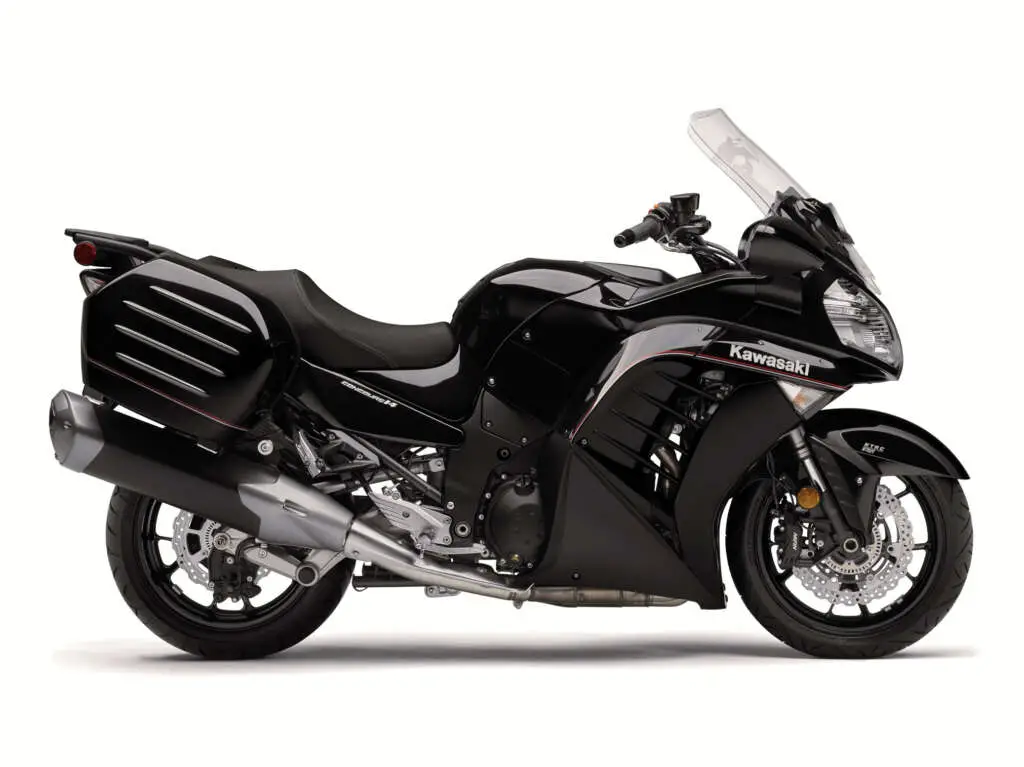
2022 Kawasaki Concours 14 ABS: THE ULTIMATE SPORT-TOURER.
Introducing the 2022 Kawasaki Concours 14 ABS…
With Kawasaki Ninja sportbike-inspired performance, the Concours 14 ABS provides the ultimate sport-touring platform that is equally adept at carving canyons, devouring highways and negotiating city streets.
The Kawasaki Concours14 ABS motorcycle features the heart of a Ninja ZX™-14R sportbike and adds superior performance, advanced technology, and premium features for the ultimate sport touring experience. The Concours14 ABS comes with the confidence of a 36-month limited warranty and features a 1352cc in-line four-cylinder engine with Variable Valve Timing (VVT), Kawasaki Advanced Coactive Braking Technology (K-ACT) ABS system, electrically adjusted windshield, standard hard saddlebags, and a rigid monocoque frame, and is available in Metallic Spark Black
The Kawasaki Concours14 ABS motorcycle gets the soul of a Ninja ZX™-14R sportbike and adds superior performance, advanced technology and premium features for the ultimate sport touring experience. And to top it off, the Concours14 ABS comes with the confidence of a 36-month limited warranty.
The 2022 Kawasaki Ninja 1000SX and Concours 14 ABS motorcycles are ready to take on the next set of winding roads with power and grace, bringing excitement and fun to your next sport-touring ride.
2022 Kawasaki Concours 14 ABS Totalmotorcycle.com Key Features
- 1,352cc INLINE FOUR-CYLINDER WITH VARIABLE VALVE TIMING (VVT)
- KAWASAKI ADVANCED COACTIVE-BRAKING TECHNOLOGY (K-ACT) ABS SYSTEM
- NINJA INSPIRED CHASSIS AND ENGINE
- POWERFUL ENGINE WITH VARIABLE VALVE TIMING PRODUCES ABUNDANT TORQUE
- KAWASAKI TRACTION CONTROL (KTRC)
- KAWASAKI ADVANCED CO-ACTIVE-BRAKING TECHNOLOGY (K-ACT)
- HEATED GRIPS
- TETRA-LEVER SHAFT DRIVE PROVIDES NATURAL RIDE QUALITY
2022 Kawasaki Concours 14 ABS Totalmotorcycle.com Features and Benefits
Dual Throttle Valves
Late-model sport bikes often use large-bore throttle bodies to generate high levels of power. However, with large diameter throttles, when a rider suddenly opens the throttle, the unrestricted torque response can be strong. Dual throttle valve technology was designed to tame engine response while contributing to performance.
On models with dual throttle valves, there are two throttle valves per cylinder: in addition to the main valves, which are physically linked to the throttle grip and controlled by the rider, a second set of valves, opened and closed by the ECU, precisely regulates intake airflow to ensure a natural, linear response. With the air passing through the throttle bodies becoming smoother, combustion efficiency is improved and power is increased.
Economical Riding Indicator
Using high-precision electronic control for engine management, Kawasaki models can achieve a high level of fuel efficiency. However, fuel consumption is greatly affected by throttle use, gear selection, and other elements under the rider’s control. The Economical Riding Indicator is a function that indicates when current riding conditions are consuming a low amount of fuel. The system continuously monitors fuel consumption, regardless of vehicle speed, engine speed, throttle position and other riding conditions. When fuel consumption is low for a given speed (i.e. fuel efficiency is high), an “ECO” mark appears on the instrument panel’s LCD screen. By riding so that the “ECO” mark remains on, fuel consumption can be reduced.
While effective vehicle speed and engine speed may vary by model, paying attention to conditions that cause the “ECO” mark to appear can help riders improve their fuel efficiency – a handy way to increase cruising range. Further, keeping fuel consumption low also helps minimize negative impact on the environment.
ECU
Activating the Fuel Economy Assistance Mode switches the ECU to a leaner fuel map in which ignition timing and fuel injection prioritize fuel economy. Rather than engine response or power, this mode favors reduced fuel consumption, aiming to increase fuel economy when riding at a constant speed. When riding in areas where gas stations are scarce, or when cruising across the continent, being able to make the same amount of fuel last longer is a considerable benefit.
Maximizing the effectiveness of the Fuel Economy Assistance Mode requires a gentle use of the throttle. Nevertheless, especially when used in conjunction with the Economical Riding Indicator, this mode can contribute to significant savings in fuel costs over long distances.
KTRC (Kawasaki Traction Control) (1-mode)
When accelerating on a slippery surface, the rear wheel may spin (i.e. when the rear wheel turns faster than the front wheel). KTRC was designed to minimize wheel spin that could otherwise cause the loss of control of the bike. Like ABS helps prevent wheels from locking up when braking, Kawasaki’s original traction control system minimizes rear tire slippage. Knowing that the system will intervene to prevent sudden wheel spin when, for example, the pavement comes to an abrupt end when touring, is a great source of reassurance for riders.
KTRC uses wheel speed sensors to monitor front and rear wheel speed. When it detects wheel spin, engine power is reduced to allow rear wheel grip to be regained. KTRC also helps the rear wheel regain traction in situations where grip is lost temporarily, like when riding over a wet manhole cover.
KTRC uses 3-way control, governing ignition timing, fuel volume and (via the sub-throttle valves) intake air volume. This 3-way control is what enables the system to be so smooth, resulting in a very natural feeling.
K-ACT (Kawasaki Advanced Coactive-braking Technology) ABS
At its heart, K-ACT ABS is an advanced anti-lock braking system, designed to keep tires from locking up during braking. But K-ACT ABS was designed to be used on touring models weighing in excess of 300 kg (661 lb) – and that is before adding a passenger and luggage.
Complementing its standard ABS function, K-ACT ABS links the front and rear brakes. It monitors the brake force the rider is exerting at both the front and rear, and takes into consideration vehicle speed to ensure highly effective braking while maintaining chassis stability.
For example, let’s say the rider pulls on the front brake lever. To keep the bike from pitching forward, the ABS ECU actuates the rear brake (via fluid pumps) to ensure that front-rear balance is maintained. Should the rider push the rear brake pedal, the system actuates the front brake as well to distribute the load more evenly so that the rear wheel does not lock up. Based on the vehicle speed, K-ACT decides the optimum hydraulic pressure to send to each caliper, ensuring that even with a heavy motorcycle, stable braking performance is possible.
KIPASS (Kawasaki’s Intelligent Proximity Activation Start System)
With the compact key fob (portable immobilizer) in a pocket, KIPASS allows riders to remotely release the bike’s steering lock and main switch simply by approaching the bike.
When the key fob is close to the bike, the signal it sends out is picked up and recognized by the KIPASS unit in the bike. Like immobilizer keys, each key fob has a unique signal, making this system also useful as a theft deterrent. The key fob can be recognized when in a jacket pocket, so there is no need for the rider to remove the key to operate the bike’s main switch.
*This system uses the encryption algorithm “MISTY” developed by MITSUBISHI ELECTRIC CORPORATION.
Kawasaki’s monocoque frame
Kawasaki’s monocoque frame is a hollow composite of aluminum parts. Originally conceived by Kawasaki engineers, it uses the engine as a fixed member so that chassis rigidity is formed not only by the frame, but the combination of the frame and engine together. Joining the engine and front and rear suspension units, the hollow box-style frame envelops the engine from above. In addition to being made from lightweight materials, its main section also acts as the air cleaner box and battery box, enabling parts to be reduced for even greater weight savings. Further, because the frame does not run beneath or alongside the engine, the chassis can be made very compact. Especially on large-displacement models, the slim chassis design of the aluminum monocoque frame contributes to ease of riding.
The aluminum monocoque frame was originally developed by Kawasaki in the 1980s for their World Grand Prix works racer. In an era where steel pipe frames were the norm, the aluminum monocoque frame that debuted on the KR500 took the world by surprise. First featured on a mass-production model on the 2000 Ninja® ZX™-12R, this original Kawasaki technology has evolved and can be found on some of our large-displacement flagship models.
Tire Pressure Monitoring System (TPMS)
Maintaining the correct tire air pressure is very important as it can greatly affect a motorcycle’s performance. Tire air escapes naturally over time, so it is also important to check tire pressure regularly. The Tire Pressure Monitoring System continuously measures tire pressure (using sensors attached to the air valves of each wheel) and displays the current pressure on the bike’s instrument panel while riding.
Tire air pressure varies greatly as the tires warm up, but the Tire Pressure Monitoring System takes this into consideration and recalculates the pressure for 20°C (68°F) to avoid confusion and false warnings.
When tire air pressure is excessively low, a tire mark appears on the display, warning the rider. This can contribute to rider peace of mind on long tours.
2022 Kawasaki Concours 14 ABS – Totalmotorcycle.com USA Specifications/Technical Details
US MSRP Price: $15999 USD
Canada MSRP Price: $18999 CDN
Europe/UK MSRP Price: £ See Dealer GBP (On The Road inc 20% Vat)
Engine Type 4-Stroke, 4-Cylinder, Liquid-Cooled, DOHC, 4 Valve Cylinder Head
Displacement 1352 cc
Bore & Stroke 84.0 x 61.0 mm
Maximum Torque 101 lb-ft @ 6,200 rpm
Compression Ratio 10.7:1
Fuel Injection DFI® with Mikuni 40mm Throttle Bodies (4)
Ignition TCBI with Digital Advance
Transmission 6-Speed with Positive Neutral Finder
Final Drive Shaft
Rake/Trail 26.0° / 4.4 in.
Front Wheel Travel 4.4 in.
Rear Wheel Travel 5.4 in.
Front Tire Size 120/70-17
Rear Tire Size 190/50-17
Wheelbase 59.8 in.
Front Suspension 43mm Inverted Cartridge Fork with Adjustable
Preload and Rebound Damping
Rear Suspension Tetra-Lever Swingarm and Uni-Trak with
Adjustable Preload, Stepless Rebound Damping
Front Brake Type Dual Floating 310mm Petal Discs with 4-Piston Calipers
Rear Brake Type Single 250mm Petal Disc
Fuel Tank Capacity 5.8 gal.
Seat Height 32.1 in.
Curb Weight= w/o Saddlebags 673 lb.
w/ Saddlebags 690 lb.
Warranty 36 months
Kawasaki Protection Plus™ 12, 24, or 36 months
(Specifications subject to change without notice.)
= Includes all necessary materials and fluids to operate correctly, full tank of fuel (more than 90% of capacity) and tool kit (if supplied).
When equipped, 50-state models with evaporative emissions equipment adds approximately 2.2 pounds.
(KP) = See Kaw-Pedia section for more details.* = Changes from previous model year.
2022 Kawasaki Concours 14 ABS – Totalmotorcycle.com Canadian Specifications/Technical Details
POWER
Engine 1,352cc, liquid-cooled, 4-stroke, DOHC 16-valve in-line four
Bore x Stroke 84.0 x 61.0 mm
Compression Ratio 10.7:1
Fuel System Fuel injection: ø40 mm x 4
Ignition Digital
Starting Electric
Lubrication Forced lubrication, wet sump
Transmission 6-speed, return
Clutch Wet multi-disc, manual
Final Drive Shaft
PERFORMANCE
Frame Monocoque, aluminum
Front Suspension / Wheel Travel ø43 mm inverted fork with rebound damping and spring preload adjustability / 113 mm (4.4 in)
Rear Suspension / Wheel Travel Bottom-Link Uni Trak + Tetra-Lever, gas-charged shock with rebound damping and spring preload adjustability / 136 mm (5.4 in)
Rake / Trail 26° / 112 mm
Steering Angle (L/R) 31° / 31°
Front Tire 120/70ZR17M/C (58W)
Rear Tire 190/50ZR17M/C (73W)
Front Brakes Dual semi-floating ø310 mm petal discs with radial-mount, opposed 4-piston, 4-pad calipers
Front Brake ø270 mm petal disc with opposed 2-piston caliper
DETAILS
Dimensions (L x W x H) 2,230 x 790* x 1,465/1,345 mm (high/low) (87.8 x 31.1* x 57.7/53.0 in (high/low)) (*Width without saddlebags)
Wheelbase 1,520 mm (59.8 in)
Road Clearance 125 mm (4.9 in)
Seat Height 815 mm (32.1 in)
Curb Mass** 305 kg (672 lb) without saddlebags
Fuel Capacity 22 litres
Instrumentation Analogue-style speedometer and tachometer + multi-function LCD screen with fuel gauge, odometer, dual trip meters, clock, current and average fuel consumption, remaining range, outside air temperature, coolant temperature, tire pressure, battery voltage, K-ACT mode indicator, Economical Riding Indicator, Fuel Economy Assistance Mode icon, and indicator lamps
Warranty 36 months
Kawasaki Protection Plus 12 / 24 / 36 / 48 months
2022 Kawasaki Concours 14 ABS – Totalmotorcycle.com European Specifications/Technical Details
NA
Manufacturer Specifications and appearance are subject to change without prior notice on Total Motorcycle (TMW).







